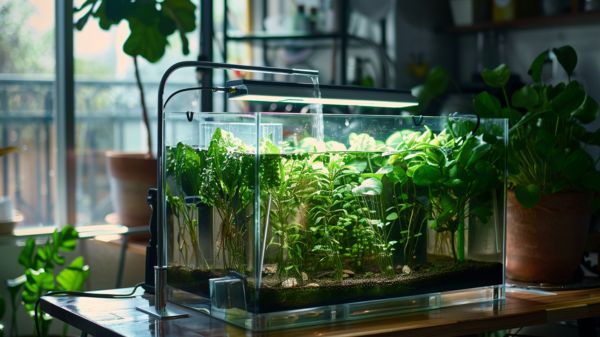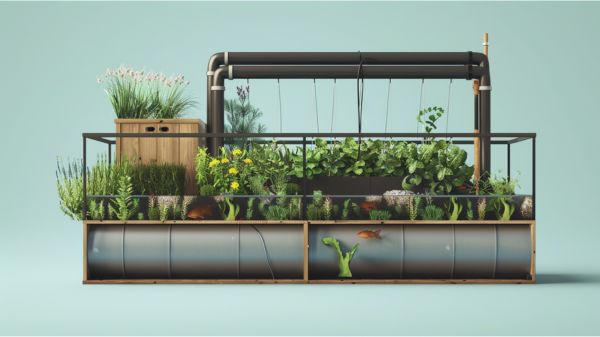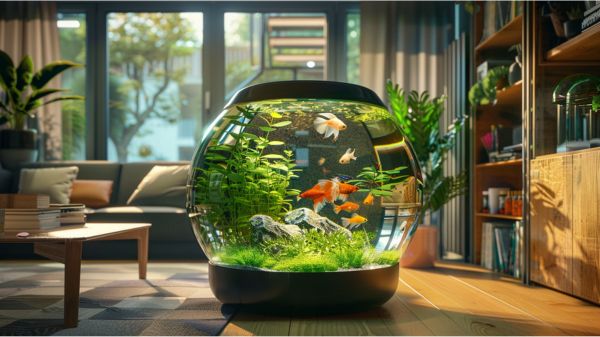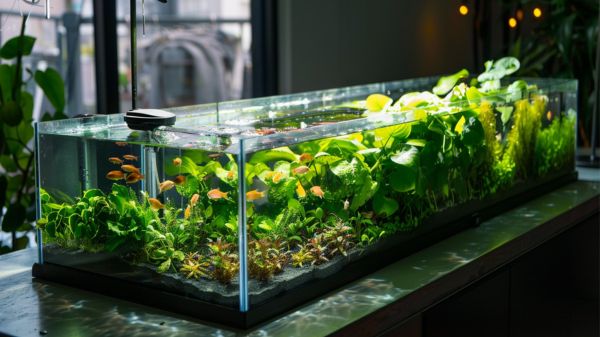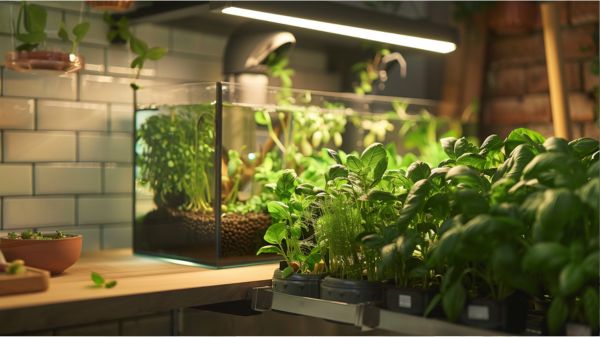Aquaponic Herb Garden Indoor: Tips for Successful Growth
Embarking on the journey of fostering an indoor aquaponic herb garden necessitates a scrupulous approach to confirm peak growth outcomes.
From the initial selection of herb varieties and aquaponics system type to the maintenance of ideal growing conditions, each step plays a crucial role in the success of your herbal oasis.
Factors such as nutrient levels, lighting, and plant-fish symbiosis are just the beginning of the intricate web of considerations that contribute to a flourishing indoor herb garden.
By understanding the nuances of herb cultivation in an aquaponic system, you pave the way for a rewarding and sustainable gardening experience.
Key Takeaways
- Maintain pH between 6.0-7.0 for optimal nutrient absorption and plant health
- Provide suitable lighting and water temperature for herb growth
- Regularly monitor water quality and system maintenance for successful growth
- Choose appropriate tank size and planting techniques for a thriving aquaponic herb garden
Herb Selection for Aquaponics
When selecting herbs for your indoor aquaponic system, it is important to carefully consider the specific pH and temperature requirements of each herb to guarantee maximum growth and harvest yields.
Herb varieties such as basil, watercress, sage, parsley, and chives are excellent choices for aquaponics due to their adaptability to this growing method. Basil, for instance, thrives in a pH range of 5.5-6.5 and temperatures between 65°-85°F, making it suitable for aquaponic setups.
Watercress, on the other hand, prefers cooler temperatures and can tolerate slightly alkaline conditions. Sage benefits from ample sunlight, requiring around 8 hours per day, and spacing of 18-27 inches between plants for best growth.
Parsley, known for its disease-fighting properties, needs at least 5 hours of sunlight daily and should be spaced 15-30 cm apart in your aquaponics system. Chives, with their mild flavor perfect for various dishes, prefer a pH range of 6.1-6.8 and temperatures ranging from 65°-80°F.
By selecting herbs that align with these pH, temperature, and sunlight requirements, you can set the stage for a successful indoor aquaponic herb garden.
Aquaponic System Setup
For optimum functionality and efficiency in your indoor aquaponic herb garden, the aquaponic system setup plays a pivotal role in supporting plant growth and maintaining overall system health.
When setting up your aquaponic system, consider the following key points:
- Tank Size: Choose a suitable tank size, like a 10-gallon tank, to provide ample space for plant growth in your indoor aquaponic herb garden.
- Setup Costs: To keep costs low, explore affordable tank options from sources like craigslist, yard sales, or thrift stores when setting up your indoor aquaponics system.
- Gravel-Filled Top Tray: Opt for a simple setup without substrate by using a gravel-filled top tray. This method effectively supports plant growth in your aquaponic herb garden.
- Water Circulation: Utilize a small fountain pump in the top tray filled with gravel to ensure efficient water circulation throughout your aquaponic system, promoting healthy plant growth.
Remember to feed your fish quality food to maintain their health, which is vital for the success of your aquaponic herb garden.
Optimal Growing Conditions
To guarantee the peak growth of herbs in an indoor aquaponic system, maintaining specific environmental conditions is paramount for the health and productivity of the plants. Initially, make sure the water temperature remains stable between 65-75°F, as this range is ideal for herb growth in aquaponic setups.
Lighting is important; provide 12-16 hours of combined natural and artificial light to simulate sunlight and promote photosynthesis essential for herb growth. Additionally, maintaining a pH level between 6.0-7.0 is essential for supporting nutrient absorption by the herbs.
Regularly monitor water quality parameters such as ammonia, nitrites, and nitrates to prevent any stress on both plants and fish. Adequate air circulation and humidity levels are also necessary to create an ideal environment for herb growth in the indoor aquaponic garden.
Herb Planting Techniques
Utilize net pots filled with clay pebbles or expanded shale as the preferred growth medium for herb plants within the indoor aquaponic system. When planting herb seeds or seedlings in the net pots, make sure that the roots are well-covered by the growth medium to provide stability and facilitate nutrient absorption.
Place these net pots in the grow bed or raft system of the aquaponic setup to allow the herb plants to flourish and thrive in a controlled environment. To support healthy herb growth, monitor the water quality regularly to guarantee adequate nutrient levels.
Adjust the pH levels of the water within the aquaponic system to maintain a prime range, typically between 6.0 and 7.0, which is conducive to the development of herb plants. By following these herb planting techniques, you can create an ideal environment for your indoor aquaponic herb garden to thrive and produce a bountiful harvest.
Maintenance and Troubleshooting
When maintaining an indoor aquaponic herb garden, regular monitoring of water levels, pH, and plant health is essential to guarantee system performance and prevent potential issues such as nutrient deficiencies or water quality problems.
Troubleshooting in aquaponic systems involves addressing problems like algae growth, fish stress, and nutrient deficiencies promptly to avoid detrimental effects on plant and fish health.
Cleaning the system periodically is important to prevent clogs, bacterial buildup, and maintain best water quality. Conducting regular water tests is necessary to guarantee proper nutrient levels for both plants and fish, as imbalances can lead to poor growth or even fatalities.
Any signs of unusual fish behavior, wilting plants, or water discoloration should be addressed immediately to prevent larger issues from arising.
Frequently Asked Questions
How Do You Promote Plant Growth in Aquaponics?
Promote plant growth in aquaponics by ensuring ideal nutrient balance, maintaining water quality, meeting lighting needs, controlling temperature, monitoring pH and oxygen levels, preventing pests, fostering root health, applying correct pruning techniques, and timing harvests strategically for successful growth.
What Is the Key to a Successful Aquaponics System?
The key to a successful aquaponics system lies in maintaining prime water quality, ensuring fish health, balancing nutrients, regular system maintenance, monitoring pH levels, controlling water temperature, providing proper lighting for photosynthesis, promoting root development, preventing pests, and adopting effective harvesting techniques.
How Do You Stimulate Herb Growth?
To stimulate herb growth effectively, guarantee adequate light intensity, maintain peak water quality, balance nutrients, control temperature, apply proper pruning techniques, guarantee air circulation, prevent pests, monitor pH levels, promote root development, and follow a precise harvesting schedule.
What Are the Best Herb Growing Tips?
Ideal herb growth in aquaponic systems requires attention to natural sunlight exposure, nutrient-rich water, proper pruning techniques, adequate space for plant development, regular watering schedules, pest control measures, temperature and humidity regulation, fertilizer application, and high-quality soil maintenance.
Conclusion
To sum up, successful growth of herbs in an indoor aquaponic system requires careful consideration of herb selection, system setup, best growing conditions, planting techniques and maintenance.
By following these tips and ensuring proper nutrient levels, lighting, water temperature, and system maintenance, herb cultivation can thrive in an indoor aquaponic garden.
Attention to detail and regular monitoring are essential for achieving healthy and abundant herb growth in this controlled environment.


